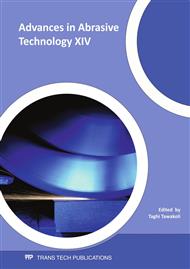p.300
p.309
p.315
p.321
p.327
p.333
p.339
p.345
p.351
Ultra High-Speed Cutting Experiment under the Cutting Condition that Cutting Speed Exceeds Plastic Wave Speed of Workpiece
Abstract:
Raising a cutting speed to above speed of a plastic wave of a workpiece material induces the high levels of the hydrostatic stresses in the shear zone, because a plastic wave traveling there becomes a shock wave. In order to ascertain the cutting phenomena occurring under the ultra high-speed cutting condition, the cutting experiments of a pure lead with cutting speeds of up to 140 m/s are performed with a high-speed impact cutting tester developed. The experimental result reveals that the cutting mechanism, especially chip formation, changes remarkably and the friction angle at the tool-chip interface rises in the ultra high-speed cutting. It can be explained that these phenomena arise from the plastic shock wave in the shear zone.
Info:
Periodical:
Pages:
327-332
Citation:
Online since:
August 2011
Authors:
Price:
Сopyright:
© 2011 Trans Tech Publications Ltd. All Rights Reserved
Share:
Citation:


